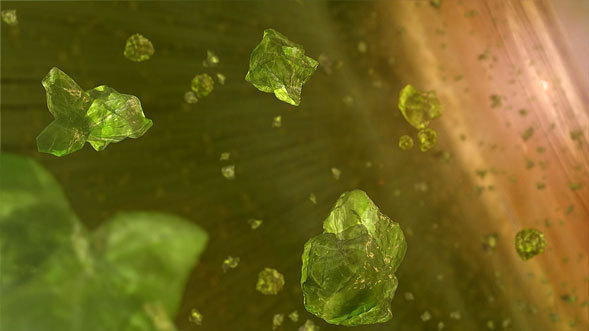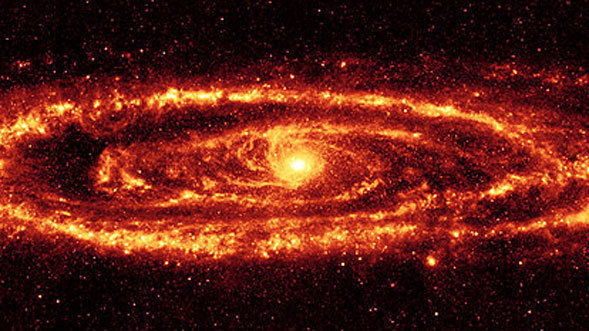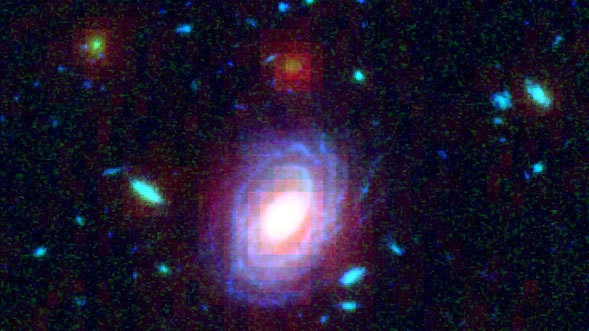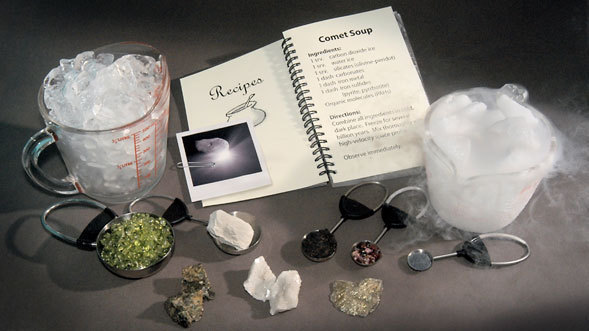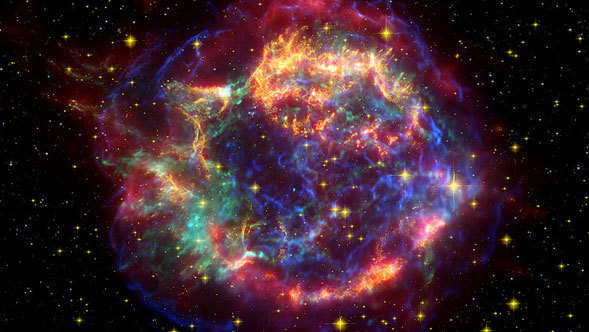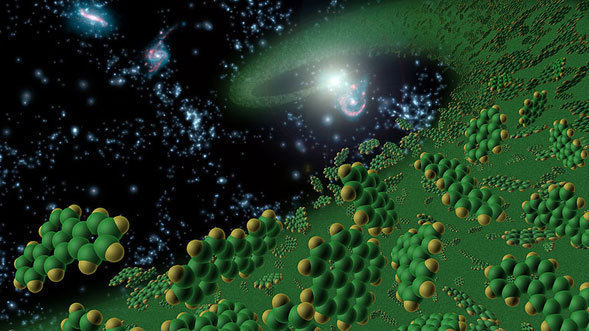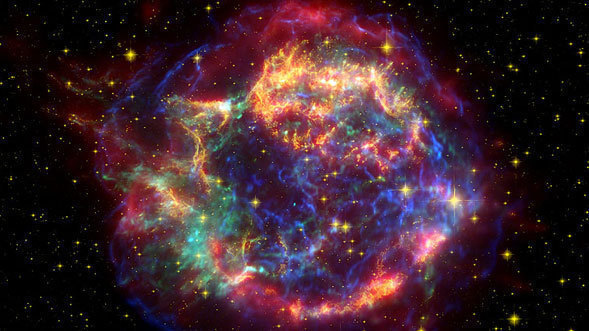Displaying news 511 - 540 of 587 in total
A new image from NASA's Spitzer Space Telescope reveals billowing mountains of dust ablaze with the fires of stellar youth.
It's another sunny Tuesday morning in Southern California and a handful of infrared scientists have flocked to the roof of the Spitzer Science Center for this week's "First Seven Minutes" meeting.
Scientists using NASA's Spitzer Space Telescope say they have detected light that may be from the earliest objects in the universe. If confirmed, the observation provides a glimpse of an era more than 13 billion years ago when, after the fading embers of the theorized Big Bang gave way to millions of years of pervasive darkness, the universe came alive.
Unsuspecting prey be warned! Hiding in the darkest corner of the constellation Circinus is a gigantic black widow spider waiting for its next meal. For decades, this galactic creepy crawler has remained largely invisible, cunningly escaping visible-light detection. At last, it has finally been caught by NASA's Spitzer Space Telescope's dust-piercing, infrared eyes.
NASA's Spitzer Space Telescope has spotted the very beginnings of what might become planets around the puniest of celestial orbs -- brown dwarfs, or "failed stars."
Before it was discovered that gravity pulled comets across the sky, many peoples and cultures perceived these cosmic objects as bad omens or "big bullies." They were often blamed for plagues and wars on Earth. In movies this image of the bully comet is perpetuated as they are often portrayed as hard chunks of ice barreling towards Earth to aid in the extinction of humanity. Recently, with a little help from NASA'S Deep Impact Mission and the Spitzer Space Telescope, comet Tempel 1 was finally able to reveal the soft and fluffy side of comets, showing that they are more like cotton candy than massive bully boulders.
NASA's Spitzer Space Telescope has captured a stunning infrared view of Messier 31, the famous spiral galaxy also known as Andromeda.
Two of NASA's Great Observatories, the Spitzer and Hubble Space Telescopes, have teamed up to "weigh" the stars in several distant galaxies. One of these galaxies, among the most distant ever seen, appears to be unusually massive and mature for its place in the young universe.
On August 23 and 25, NASA's Spitzer Spitzer Space Telescope looked toward the recently discovered planet beyond Pluto, identified as 2003UB313. The observations were scheduled after an earlier attempt failed due to an error by the Spitzer project team in processing the request. Spitzer measures the amount of heat given off by planets and other objects, enabling researchers to infer the overall size of the bodies. The results of the recent observations are currently being analyzed.
When Deep Impact smashed into comet Tempel 1 on July 4, 2005, it released the ingredients of our solar system's primordial "soup." Now, astronomers using data from NASA's Spitzer Space Telescope and Deep Impact have analyzed that soup and begun to come up with a recipe for what makes planets, comets and other bodies in our solar system.
Four days after its launch on August 25, 2003, NASA's Spitzer Space Telescope opened its infrared eyes for the first time and immediately performed beyond all expectations by providing the world with one of the deepest infrared images ever taken. Two years later, Spitzer continues to surpass expectations by uncovering a hidden universe teeming with warm stellar embryos, chaotic planet-forming disks, majestic galaxies, hidden black holes, remnants of dead stars, and much more.
University of Wisconsin, Madison
National Optical Astronomy Observatory (NOAO) scientist Dr. Steve Howell once likened a low mass star in a cataclysmic variable (CV) binary system to an aggrieved partner in a romantic relationship, that will "give, and give, and give some more until it has nothing left to give." In a CV system, the relationship taker is a dead star or, "white dwarf" (WD) which releases energy and light as it wraps itself in its partner's mass and forms a disk of material also known as an accretion disk.
On August 15, 2005 at approximately 7:11 p.m. Pacific Daylight Time, NASA's Spitzer Space Telescope will begin its 10,000th hour of science observations.
Since its launch nearly two years ago, NASA's Spitzer Space Telescope has taken the public on a journey to the darkest and dustiest places of the cosmos. Its stunning infrared images continue to dazzle us with new views of hidden nebulas and whirling galaxies. Some people might think those images magically arrive from space, while astronomers have a better understanding of the complex process involved in creating Spitzer pictures.
Later this month, the Spitzer Space Telescope will look toward the recently-discovered planet beyond Pluto, an object identified as 2003UB313. After the new object was announced, the Spitzer team discovered that the telescope's previous observations of the object were unsuccessful because of an error in the parameters used to target it. A successful Spitzer detection will determine the object's size. If Spitzer does not see it, astronomers will be able to place a solid upper limit on its size. The object was discovered by Dr. Michael Brown of Caltech, along with Dr. Chad Trujillo of Gemini Observatory in Hawaii, and Dr. David Rabinowitz of Yale University in Connecticut.
Most of the biggest black holes in the universe have been eating cosmic meals behind closed doors -- until now.
NASA's Spitzer Space Telescope has found the ingredients for life all the way back to a time when the universe was a mere youngster.
For the second time, Spitzer Legacy science teams have released their most recent data and value-added projects to the public via the World Wide Web.
Harvard-Smithsonian Center for Astrophysics
Smiling, Spitzer Staff Scientist Dr. Ranga-Ram Chary silently watched as 17-year old Katie Mills explained a complex plot of spikes and dips to Pasadena Star News reporter Kimm Groshong. Ironically, just two days before this interview, upon her arrival at the Spitzer Science Center (SSC), the North Carolina teen worried that she wasn't "smart enough to do Dr. Chary's job."
On June 22, 2005, NASA honored the Spitzer Space Telescope's groundbreaking contributions to the field of astronomy at the NASA Honor Awards ceremony, hosted by the Jet Propulsion Laboratory in Pasadena, Calif.
Locked in the core of comet Tempel 1 are mystery ingredients that may explain the creation of planets, and the conditions of the early solar system. After six years of preparation and 268 million miles of travel, NASA's Deep Impact spacecraft will finally unleash these secrets by placing its impactor spacecraft in the path of the hurtling comet, which is zooming along at a relative speed of 23,000 miles per hour. This collision will create a plume of cosmic dust and a large crater on the face of the comet. Watching from the sideline will be Deep Impact's flyby spacecraft and, farther away, the Spitzer Space Telescope.
An enormous light echo etched in the sky by a fitful dead star was spotted by the infrared eyes of NASA's Spitzer Space Telescope.
On July 4, NASA's Deep Impact spacecraft will attempt an extraordinarily daring encounter with the far-flung comet Tempel 1, which is hurtling through space at tens of thousands of miles per hour. As if that is not challenging enough, the comet's size, shape and other characteristics are not entirely known.
Twice a year, the American Astronomical Society, or AAS, meets so scientists can share their research with their peers. The 206th AAS meeting is taking place from May 29 through June 2, 2005 in Minneapolis, and many Spitzer researchers are attending.
The saga of how a few monstrous stars spawned a diverse community of additional stars is told in a new image from NASA's Spitzer Space Telescope.
The Spitzer Space Telescope is currently executing its first-ever High Impact Target of Opportunity (ToO) observation in order to catch a look at the aftermath of one of the most violent explosions in the universe. The ToO program was designed as a means to interrupt Spitzer's normal observation schedule in the case of an extraordinary event.
How does an idea become an observation on the Spitzer Space Telescope? Every year in February, astronomers from around the world submit proposals, requesting observations with Spitzer. In April, the Time Allocation Committee (TAC) meets, considers these proposals, and selects the very best to comprise Spitzer's next year of observations.
Displaying news 511 - 540 of 587 in total




